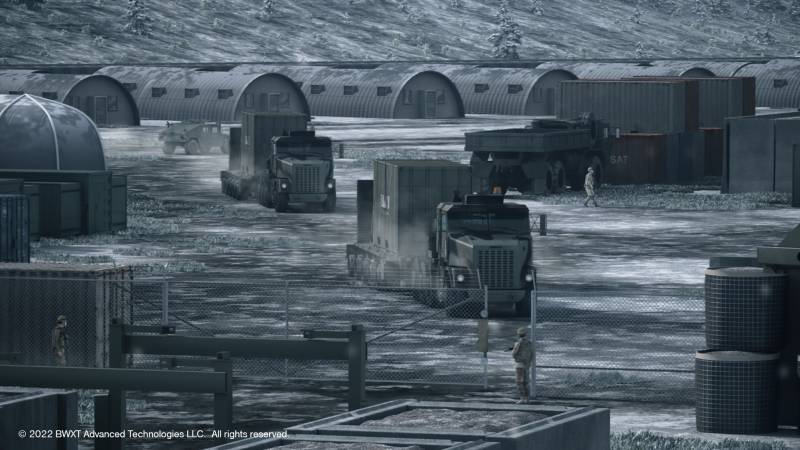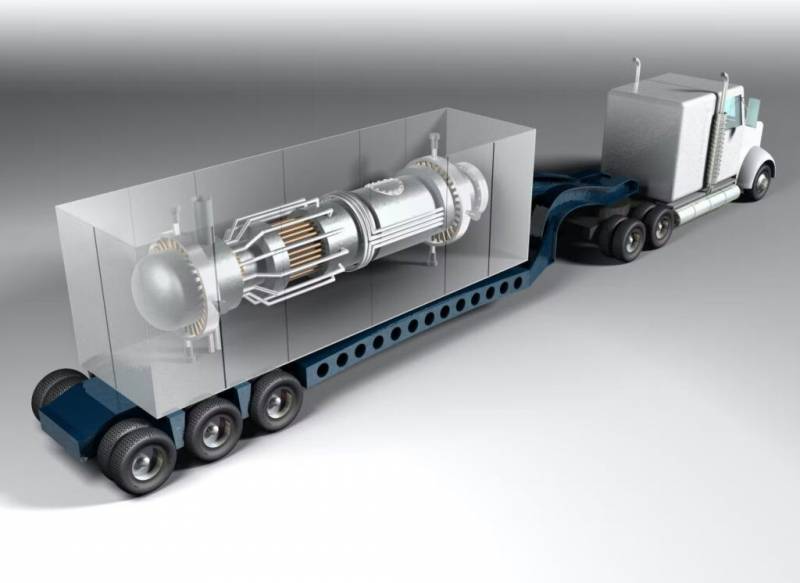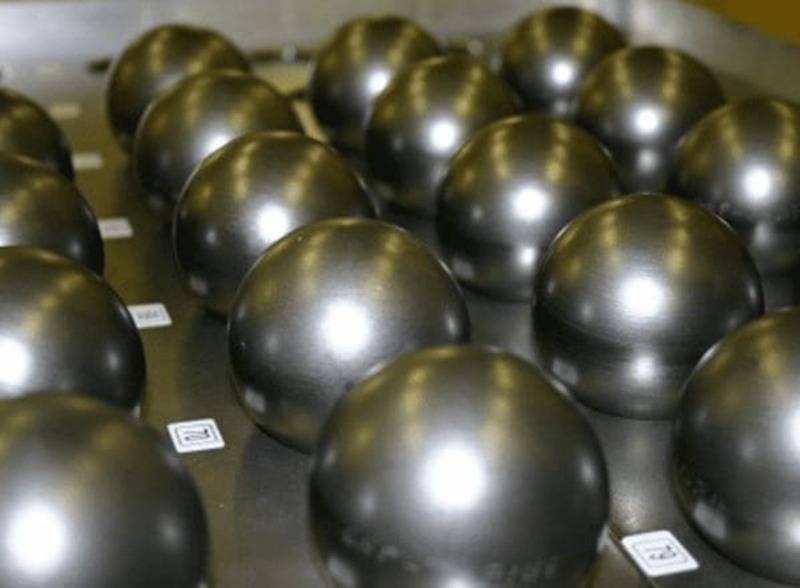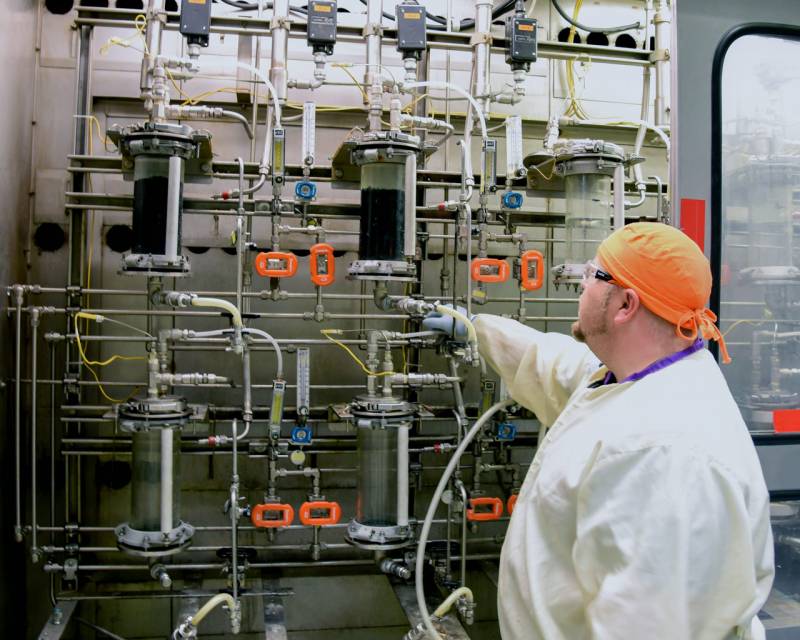Pele project: a reactor that is always with you

The gloomy future of Pele mini-nuclear power plant. Source: pipedot.org
The perfect gadget
The idea to tame a nuclear reactor for military purposes and make it no more than a field technical equipment has been in the minds of engineers for a very long time.
The first were Soviet designers with a caterpillar nuclear power plant TES-3 back in the late 50s. It cannot be called compact - the nuclear reactor with infrastructure was placed on four chassis of heavy tanks. The station worked flawlessly, had a long service life and could well supply electricity and heat to a remote garrison. But the dimensions and exorbitant weight of TPP-3 did not allow further improvement of the design.
At a new level, the concept of a mobile nuclear station was continued in the early 80s, when the Soviet industry offered the Pamir-630D product to the series. If TPP-3 was made according to the classical scheme of a pressurized water reactor, then at Pamir the coolant was the Nitrin compound based on dinitrogen tetroxide. This made it possible to reduce the dimensions of the reactor and raise the temperature at the outlet of the hot zone to 500 degrees Celsius. The station was placed on two heavy trawls, the tractors of which were Belarusian MAZs in a special design. Unlike TES-3, a pair of semi-trailers could move along public roads and quite decent off-road.
It just turned out as a result of a real explosive mixture on wheels. Not only was there almost twenty kilograms of highly enriched uranium dioxide in the reactor, but also the coolant turned out to be surprisingly toxic. It is alleged that during the run-in of the working processes of the reactor, one of the developers was poisoned by Nitrin to death. After the Chernobyl accident, the project was closed, and since then nothing has been heard about domestic projects of mobile nuclear reactors.
But the idea of power supply for separated military garrisons from small-sized nuclear power plants was not abandoned. Especially in light of the development of the Northern Sea Route.
In the United States, the first experiences with mobile stations date back to the early 60s. It was the ML-1 Mobile Power System that was to revolutionize the industry.
First, to reduce the size, the engineers took a big risk and pumped the reactor with nitrogen. In theory, it was supposed to play the role of a coolant, and in which case its reserves could be quickly replenished from the surrounding air. But the gas cooling of the hot zone of the reactor required non-trivial solutions for sealing the circuit. The Americans were never able to solve this problem - the gas was leaking from the pipelines, and even carried a lot of radioactive particles with it.
The second unique feature of the ML-1 was its air transportability - it was the first in stories precedent of this kind. The station was placed in four standard containers and airlifted to the S-130.
As is already clear, the revolution did not happen - the design turned out to be so crude that it did not even come to trial operation in the troops.
Project Pele
The Americans use the Advanced Medium Mobile Power Source complex as the main mobile energy source, which includes five multi-fuel electric generators with a capacity of 2,5 kW to 2,5 MW. The developers claim that in comparison with their predecessors, withdrawn from service in 2011, generators are 21 percent more economical, as well as more reliable and safer.
However, the laws of physics and chemistry cannot be deceived - garrisons for power plants have to continuously supply fuel and consumables. This is, firstly, troublesome, and secondly, it increases the vulnerability of any isolated US base from attacks. It is worth blocking the caravans with fuel, and the vaunted American technology will not last long. The number of military bases in the American army has exceeded eight hundred, which creates huge problems with the delivery of fuel.
At the same time, the Pentagon is constantly increasing the number of electricity consumers in the army. The Americans plan to transfer light wheeled vehicles to electric traction in 25–30 years. And in the future, this trend is planned to be extended to all armored vehicles, up to tanks. At the same time, the United States is dreaming of laser missile defense and a bunch of gadgets that multiply the need for electricity. Therefore, if the project of a small-sized nuclear power plant for military purposes did not exist, it would have to be invented.
And the Americans are feeding taxpayers a story about reducing the notorious "carbon footprint" from military infrastructure. According to the Pentagon, in 2020 alone, the Army "used up nearly 78 million barrels of fuel to power ships, aircraft, combat vehicles and reserve bases, totaling $9,2 billion."
It seems to be an impressive figure, which nevertheless seems insignificant against the background of the Pentagon's $750 billion defense budget. And against the background of the emissions that annually deliver into the atmosphere of the United States, the share of the military barely reaches a couple of percent. Researchers have calculated that over the past three years, the US military has emitted more than fifty million tons of carbon dioxide every twelve months. Most of the world's countries are not capable, in principle, of generating such a mass of greenhouse gases.

This is what Pele might look like. Source: atomic-energy.ru
The answer to all the above questions, the Americans considered the project of a small-sized nuclear reactor of the fourth generation named Pele.
The development program started in March 2022 and should culminate for the Americans in the creation of a serial small-sized nuclear power plant with a capacity of 1 to 5 MW. At the same time, it is planned to load nuclear fuel into the reactor no more than once every three years. Interestingly, Pele should be the first generation IV reactor in the United States.
For the second time in history, the Pentagon is trying to revolutionize nuclear power - ML-1 sixty years ago was also based on untested solutions. The first prototype is planned to be created at the National Laboratory in Idaho. Generation IV NPP is a broad concept that includes several different schemes that differ both in the type of cooling and in the fuel used. The Americans for Pele chose gas cooling (hello from nitrogen ML-1) and a very specific fuel - TRISO (tristructural-isotropic).

Triso tablets. Source: www.naukatehnika.com
A ball of uranium dioxide with a diameter of 0,5 mm is wrapped in a graphite shell, followed by a layer of pyrographite, silicon carbide, and on top everything is covered with another pyrographite shell. Graphite surrounding the dioxide core is responsible for holding the fission products. Otherwise, Pele is a typical reactor - fuel is loaded into the rods, and the heat from the hot zone is transferred to the steam generator by an as yet unnamed gas. It can be helium, nitrogen, or even hydrogen - for more than half a century, Americans have learned how to build sealed and durable pipelines for any coolant.
The lead developer of the compact nuclear power plant is BWX Technologies, which makes money on the supply of nuclear fuel. The contract for the construction of the Pele prototype was signed last year and implies $300 million for this purpose. The finished product is expected by 2024. BWX began production of the “three-layer” TRISO fuel adapted for the new reactor in December 2022.

At BWX Technologies' facility in Lynchburg, Virginia. Source: atomic-energy.ru
Despite the declared safety of Pele, the Americans are well aware that in the event of even a local turmoil, a mini-nuclear power plant cannot survive even a few days. The death of even the most ultra-modern nuclear power plant from a banal mine or projectile will make the nearby territory unusable for a long time. As well as surrounding soldiers. Therefore, the Pentagon proposes to use Pele so far only on island bases and in the Arctic. In the event of a collapse, the death of several nuclear power plants, continental America will easily survive. The same cannot be said about potential adversaries.
The Pele program indirectly signals that the Americans intend to create significant competition for Russia for control of the Northern Sea Route. Mini-nuclear power plants are a tool for building up forces in the north and increasing the autonomy of individual units. And everyone will have to take this into account in the future. If Pele still plays as it should.
Information